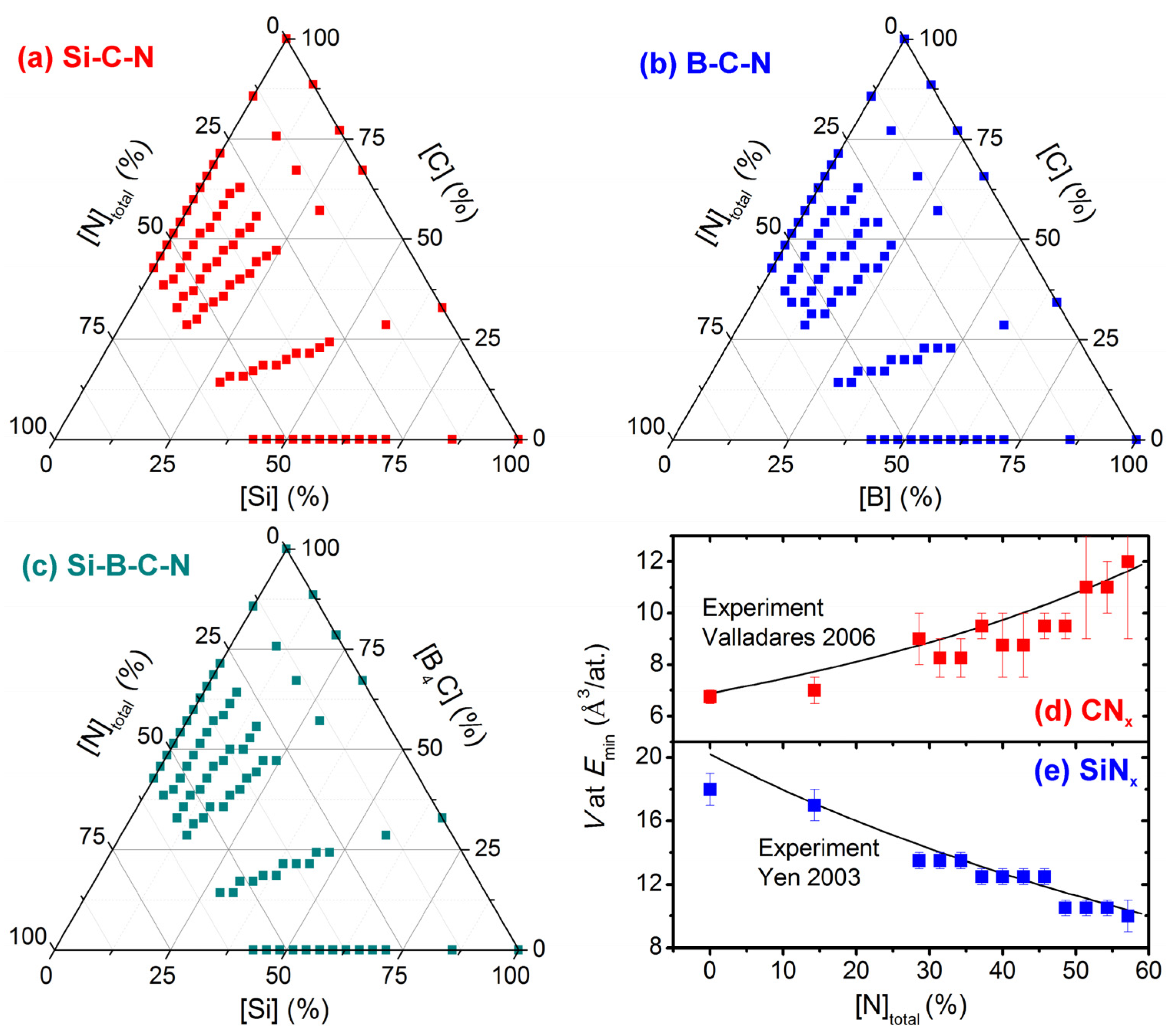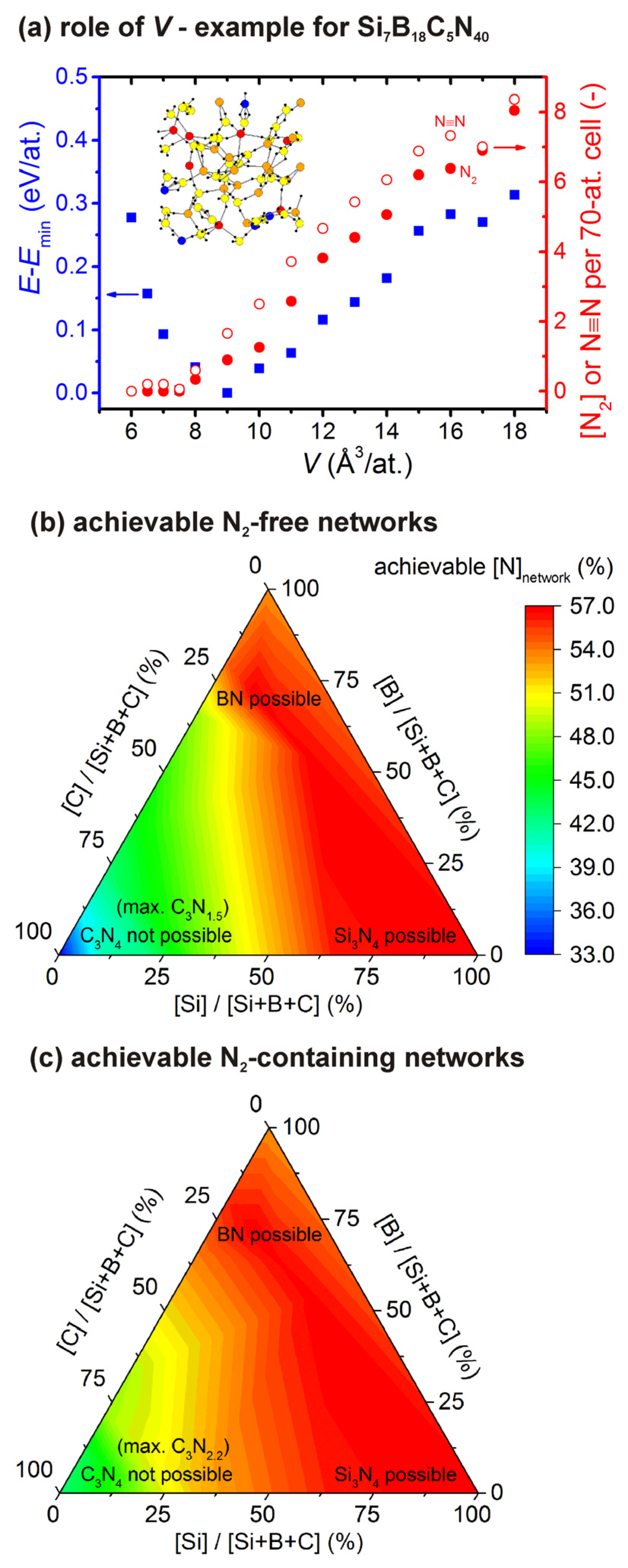Maximum Achievable N Content in Atom-by-Atom Growth of Amorphous Si-B-C-N Materials
Abstract
:1. Introduction
2. Materials and Methods
2.1. Simulation Technique
2.2. List of Simulations
- [Si]/[Si+C] of 0, ≈11, ≈22, ≈33, ≈66 and 100% at [B] = 0,
- [B]/[B+C] of 0, ≈11, ≈22, ≈33, ≈66 and 100% at [Si] = 0 and
- [Si]/[Si+B+C] of, again, 0, ≈11, ≈22, ≈33, ≈66 and 100% at [B]/[C] ≈ 4.
2.3. Reliability of the Simulation Protocol
2.4. Reactive Magnetron Sputtering
- SixC100-x (graphite overlapped by Si plates) at x = 5, 20, 40, 60 and 80%;
- SixB20C80-x (graphite overlapped by Si and B plates) at x = 5, 40, 60 and 75%; and
- Six(B4C)100-x (B4C overlapped by Si plates) at x = 0, 5, 20, 40, 60 and 75%.
3. Results and Discussion
3.1. Maximum Achievable N Content
3.2. Densification and Packing Factor
3.3. Experimental Verification
4. Conclusions
Funding
Institutional Review Board Statement
Informed Consent Statement
Data Availability Statement
Acknowledgments
Conflicts of Interest
References
- Riedel, R.; Klenzle, A.; Dressler, W.; Ruwisch, L.; Bill, J.; Aldinger, F. A Silicoboron Carbonitride Ceramic Stable to 2000 °C. Nature 1996, 382, 796–798. [Google Scholar] [CrossRef]
- Baldus, H.P.; Jansen, M. Novel High-Performance Ceramics-Amorphous Inorganic Networks from Molecular Precursors. Angew. Chem. Int. Ed. 1997, 36, 328–343. [Google Scholar] [CrossRef]
- Rooke, M.A.; Sherwood, P.M.A. Surface Studies of Potentially Oxidation Protective Si-B-N-C Films for Carbon Fibers. Chem. Mater. 1997, 9, 285–296. [Google Scholar] [CrossRef]
- Vlcek, J.; Potocky, S.; Cizek, J.; Houska, J.; Kormunda, M.; Zeman, P.; Perina, V.; Zemek, J.; Setsuhara, Y.; Konuma, S. Reactive Magnetron Sputtering of Hard Si-B-C-N Films with a High-temperature Oxidation Resistance. J. Vac. Sci. Technol. A 2005, 23, 1513–1522. [Google Scholar] [CrossRef]
- Vijayakumar, A.; Warren, A.P.; Todi, R.M.; Sundaram, K.B. Photoluminescence from RF Sputtered SiCBN Thin Films. J. Mater. Sci. Mater. Electron. 2009, 20, 144–148. [Google Scholar] [CrossRef]
- Vishnaykov, V.M.; Ehiasarian, A.P.; Vishnaykov, V.V.; Hovsepian, P.; Colligon, J.S. Amorphous Boron Containing Silicon Carbo-Nitrides Created by Ion Sputtering. Surf. Coat. Technol. 2011, 206, 149–154. [Google Scholar] [CrossRef] [Green Version]
- Zhang, P.; Jia, D.; Yang, Z.; Duan, X.; Zhou, Y. Progress of a Novel Non-Oxide Si-B-C-N Ceramic and its Matrix Composites. J. Adv. Ceram. 2012, 1, 157–178. [Google Scholar] [CrossRef]
- Kiryukhantsev-Korneev, P.V.; Sheveyko, A.N.; Levashov, E.A.; Shtansky, D.V. Investigation of the Si–B–C–N Coatings Deposited by Magnetron Sputtering of SiBC targets. Russ. J. Non-ferr. Met. 2015, 56, 540–547. [Google Scholar] [CrossRef]
- Zhao, G.; Hu, P.; Zhou, S.; Chen, G.; An, Y.; Cheng, Y.; An, J.; Zhang, X.; Han, W. Ordered Silica Nanoparticles Grown on a Three-Dimensional Carbon Fiber Architecture Substrate with Siliconborocarbonitride Ceramic as a Thermal Barrier Coating. ACS Appl. Mater. Interfaces 2016, 8, 4216–4225. [Google Scholar] [CrossRef]
- Viard, A.; Fonblanc, D.; Lopez-Ferber, D.; Schmidt, M.; Lale, A.; Durif, C.; Balestrat, M.; Rossignol, F.; Weinmann, M.; Riedel, R.; et al. Polymer Derived Si–B–C–N Ceramics: 30 Years of Research. Adv. Eng. Mater. 2018, 20, 1800360. [Google Scholar] [CrossRef]
- Ji, X.; Wang, S.; Shao, C.; Wang, H. High-Temperature Corrosion Behavior of SiBCN Fibers for Aerospace Applications. ACS Appl. Mater. Interfaces 2018, 10, 19712–19720. [Google Scholar] [CrossRef]
- Jia, D.; Liang, B.; Yang, Z.; Zhou, Y. Metastable Si-B-C-N Ceramics and Their Matrix Composites Developed by Inorganic Route Based on Mechanical Alloying: Fabrication, Microstructures, Properties and Their Relevant Basic Scientific Issues. Prog. Mater. Sci. 2018, 98, 1–67. [Google Scholar] [CrossRef]
- Luo, C.; Jiao, T.; Gu, J.; Tang, Y.; Kong, J. High-Temperature Stable and Metal-Free Electromagnetic Wave-Absorbing SiBCN Ceramics Derived from Carbon-Rich Hyperbranched Polyborosilazanes. ACS Appl. Mater. Interfaces 2018, 10, 28051–28061. [Google Scholar] [CrossRef] [PubMed]
- Shao, G.; Jiang, J.; Jiang, M.; Su, J.; Liu, W.; Wang, H.; Xu, H.; Lu, H.; Zhang, R. Polymer-derived SiBCN Ceramic Pressure Sensor with Excellent Sensing Performance. J. Adv. Ceram. 2020, 9, 374–379. [Google Scholar] [CrossRef]
- Chen, S.; Zhang, Q.; Luan, X.; Yu, R.; Zhang, S.; Cheng, L. Sapphire Optical Fiber with SiBCN Coating Prepared by Chemical Vapor Deposition for High-Temperature Sensing Applications. Thin Solid Film. 2020, 709, 138242. [Google Scholar] [CrossRef]
- Hanniet, Q.; Boussmen, M.; Barés, J.; Huon, V.; Iatsunskyi, I.; Coy, E.; Bechelany, M.; Gervais, C.; Voiry, D.; Miele, P.; et al. Investigation of Polymer-Derived Si–(B)–C–N Ceramic / Reduced Graphene Oxide Composite Systems as Active Catalysts Towards the Hydrogen Evolution Reaction. Sci. Rep. 2020, 10, 22003. [Google Scholar] [CrossRef] [PubMed]
- Houska, J.; Vlcek, J.; Potocky, S.; Perina, V. Influence of Substrate Bias Voltage on Structure and Properties of Hard Si–B–C–N Films Prepared by Reactive Magnetron Sputtering. Diam. Relat. Mater. 2007, 16, 29–36. [Google Scholar] [CrossRef]
- Kalas, J.; Vernhes, R.; Hreben, S.; Vlcek, J.; Klemberg-Sapieha, J.E.; Martinu, L. High-temperature Stability of the Mechanical and Optical Properties of Si-B-C-N Films Prepared by Magnetron Sputtering. Thin Solid Film. 2009, 518, 174–179. [Google Scholar] [CrossRef]
- Houska, J. Ageing Resistance of SiBCN Ceramics. Ceram. Int. 2015, 41, 7921–7928. [Google Scholar] [CrossRef]
- Ramakrishnan, P.A.; Wang, Y.T.; Balzar, D.; An, L.; Haluschka, C.; Riedel, R.; Hermann, A.M. Silicoboron–Carbonitride Ceramics: A class of High-Temperature, Dopable Electronic Materials. Appl. Phys. Lett. 2011, 78, 3076–3078. [Google Scholar] [CrossRef]
- Petrman, V.; Houska, J.; Kos, S.; Calta, P.; Vlcek, J. Effect of Nitrogen Content on Electronic Structure and Properties of SiBCN Materials. Acta Mater. 2011, 59, 2341–2349. [Google Scholar] [CrossRef]
- Yin, X.; Kong, L.; Zhang, L.; Cheng, L.; Travitzky, N.; Greil, P. Electromagnetic Properties of Si–C–N Based Ceramics and Composites. Int. Mater. Rev. 2014, 59, 326–355. [Google Scholar] [CrossRef]
- Vijayakumar, A.; Todi, R.M.; Sundaram, K.B. Amorphous SiCBN-based Metal-Semiconductor-Metal Photodetector for High-Temperature Applications. IEEE Electron Device Lett. 2007, 28, 713–715. [Google Scholar] [CrossRef]
- Benaissa, K.; Yang, J.Y.; Crenshaw, D.; Williams, B.; Sridhar, S.; Ai, J.; Boselli, G.; Zhao, S.; Tang, S.; Ashburn, S.; et al. RF CMOS on High-Resistivity Substrates for System-on-Chip Applications. IEEE Trans. Electron Devices 2003, 50, 567–576. [Google Scholar] [CrossRef]
- Vlcek, J.; Calta, P.; Steidl, P.; Zeman, P.; Cerstvy, R.; Houska, J.; Kohout, J. Pulsed Reactive Magnetron Sputtering of High-Temperature Si–B–C–N Films with High Optical Transparency. Surf. Coat. Technol. 2013, 226, 34–39. [Google Scholar] [CrossRef]
- Hegemann, D.; Riedel, R.; Oehr, C. PACVD-Derived Thin Films in the System Si-B-C-N. Chem. Vap. Depos. 1999, 5, 61–65. [Google Scholar] [CrossRef]
- Li, J.; Zhao, M.; Liu, Y.; Chai, N.; Ye, F.; Qin, H.; Cheng, L.; Zhang, L. Microstructure and Dielectric Properties of LPCVD/CVI-SiBCN Ceramics Annealed at Different Temperatures. Materials 2017, 10, 655. [Google Scholar] [CrossRef] [PubMed] [Green Version]
- Houska, J.; Vlcek, J.; Hreben, S.; Bilek, M.M.M.; McKenzie, D.R. Effect of B and the Si/C Ratio on High-temperature Stability of Si-B-C-N Materials. Europhys. Lett. 2006, 76, 512–518. [Google Scholar] [CrossRef]
- Muller, A.; Gerstel, P.; Weinmann, M.; Bill, J.; Aldinger, F. Correlation of Boron Content and High Temperature Stability in Si-B-C-N Ceramics. J. Eur. Ceram. Soc. 2000, 20, 2655–2659. [Google Scholar] [CrossRef]
- Houska, J. Maximum N Content in a-CNx by Ab-initio Simulations. Acta Mater. 2019, 174, 189–194. [Google Scholar] [CrossRef]
- Eftekhari, G. Reactively Sputtered Titanium Nitride Schottky Contacts on n-GaAs and Their Thermal Stability. Semicond. Sci. Technol. 1996, 11, 285–288. [Google Scholar] [CrossRef]
- Filatova, E.O.; Sakhonenkov, S.S.; Konashuk, A.S.; Kasatikov, S.A.; Afanasev, V.V. Inhibition of Oxygen Scavenging by TiN at the TiN/SiO2 Interface by Atomic-layer-deposited Al2O3 Protective Interlayer. J. Phys. Chem. C 2019, 123, 22335–22344. [Google Scholar] [CrossRef]
- Marks, N.A. Evidence for Subpicosecond Thermal Spikes in the Formation of Tetrahedral Amorphous Carbon. Phys. Rev. B 1997, 56, 2441–2446. [Google Scholar] [CrossRef]
- Han, J.C.; Gao, W.; Zhu, J.Q.; Meng, S.H.; Zheng, W.T. Density-functional Theory Study of the Microstructure, Electronic Structure, and Optical Properties of Amorphous Carbon. Phys. Rev. B 2007, 75, 155418. [Google Scholar] [CrossRef]
- Bilek, M.M.M.; McKenzie, D.R.; McCulloch, D.G.; Goringe, C.M. Ab Initio Simulation of Structure in Amorphous Hydrogenated Carbon. Phys. Rev. B 2000, 62, 3071–3077. [Google Scholar] [CrossRef]
- Merchant, A.R.; McKenzie, D.R.; McCulloch, D.G. Ab Initio Simulations of Amorphous Carbon Nitrides. Phys. Rev. B 2001, 65, 024208. [Google Scholar] [CrossRef]
- Valladares, A.A.; Alvarez-Ramirez, F. Bonding in Amorphous Carbon-nitrogen Alloys: A First Principles Study. Phys. Rev. B 2006, 73, 024206. [Google Scholar] [CrossRef]
- Fitzhenry, P.; Bilek, M.M.M.; Marks, N.A.; Cooper, N.C.; McKenzie, D.R. Wannier Function Analysis of Silicon-carbon Alloys. J. Phys. Condens. Matter 2003, 15, 165–173. [Google Scholar] [CrossRef]
- Ivashchenko, V.I.; Kozak, A.O.; Porada, O.K.; Ivashchenko, L.A.; Sinelnichenko, O.K.; Lytvynb, O.S.; Tomila, T.V.; Malakhova, V.J. Characterization of SiCN Thin Films: Experimental and Theoretical Investigations. Thin Solid Film. 2014, 569, 57–63. [Google Scholar] [CrossRef]
- Kroll, P. Modelling Polymer-derived Ceramics. J. Eur. Ceram. Soc. 2005, 25, 163–174. [Google Scholar] [CrossRef]
- Houska, J. Maximum Achievable N Content in Atom-by-atom Growth of Amorphous Si-C-N. ACS Appl. Mater. Inter. 2020, 12, 41666–41673. [Google Scholar] [CrossRef]
- Sun, Z.; Zhang, X.; Zhu, R.; Dong, X.; Xu, J.; Wang, B. Facile Synthesis of Visible Light-Induced g-C3N4/Rectorite Composite for Efficient Photodegradation of Ciprofloxacin. Materials 2018, 11, 2452. [Google Scholar] [CrossRef] [Green Version]
- CPMD 3.13.1, IBM Corp. 1990–2008, MPI fur Festkorperforschung Stuttgart 1997–2001. Available online: www.cpmd.org (accessed on 1 September 2021).
- Resta, R. Quantum-mechanical Position Operator in Extended Systems. Phys. Rev. Lett. 1998, 80, 1800–1803. [Google Scholar] [CrossRef] [Green Version]
- Yen, B.K.; White, R.L.; Waltman, R.J.; Dai, Q.; Miller, D.C.; Kellock, A.J.; Marchon, B.; Kasai, P.H.; Toney, M.F.; York, B.R.; et al. Microstructure and Properties of Ultrathin Amorphous Silicon Nitride Protective Coating. J. Vac. Sci. Technol. A 2003, 21, 1895–1904. [Google Scholar] [CrossRef] [Green Version]
- Vlcek, J.; Kormunda, M.; Cizek, J.; Soukup, Z.; Perina, V.; Zemek, J. Reactive Magnetron Sputtering of Si-C-N Films with Controlled Mechanical and Optical Properties. Diam. Relat. Mater. 2003, 12, 1287–1294. [Google Scholar] [CrossRef]
- Saarilahti, J.; Rauhala, E. Interactive Personal-computer Data Analysis of Ion Backscattering Spectra. Nucl. Instrum. Method Phys. Res. B 1992, 64, 734–738. [Google Scholar] [CrossRef]
- Mayer, M. SIMNRA, User’s Guide; Forschungscentrum Julich, Institute for Plasma Physics: Jülich, Germany, 1998. [Google Scholar]
- Houska, J.; Warschkow, O.; Bilek, M.M.M.; McKenzie, D.R.; Vlcek, J.; Potocky, S. The effect of argon on the structure of amorphous SiBCN materials: An experimental and ab initio study. J. Phys. Condens. Matter 2006, 18, 2337–2348. [Google Scholar] [CrossRef]
- Liu, A.Y.; Cohen, M.L. Structural Properties and Electronic Structure of Low-compressibility Materials: β-Si3N4 and Hypothetical β-C3N4. Phys. Rev. B 1990, 41, 10727–10734. [Google Scholar] [CrossRef]
- Ajmal, H.M.S.; Khan, F.; Huda, N.U.; Lee, S.; Nam, K.; Kim, H.Y.; Eom, T.-H.; Kim, S.D. High-Performance Flexible Ultraviolet Photodetectors with Ni/Cu-Codoped ZnO Nanorods Grown on PET Substrates. Nanomaterials 2019, 9, 1067. [Google Scholar] [CrossRef] [Green Version]
- Ajmal, H.M.S.; Khan, F.; Nam, K.; Kim, H.Y.; Kim, S.D. Ultraviolet Photodetection Based on High-Performance Co-Plus-Ni Doped ZnO Nanorods Grown by Hydrothermal Method on Transparent Plastic Substrate. Nanomaterials 2020, 10, 1225. [Google Scholar] [CrossRef]
- Vlcek, J.; Kormunda, M.; Cizek, J.; Perina, V.; Zemek, J. Influence of Nitrogen-Argon Gas Mixtures on Reactive Magnetron Sputtering of Hard Si-C-N Films. Surf. Coat. Technol. 2002, 160, 74–81. [Google Scholar] [CrossRef]




Publisher’s Note: MDPI stays neutral with regard to jurisdictional claims in published maps and institutional affiliations. |
© 2021 by the author. Licensee MDPI, Basel, Switzerland. This article is an open access article distributed under the terms and conditions of the Creative Commons Attribution (CC BY) license (https://creativecommons.org/licenses/by/4.0/).
Share and Cite
Houska, J. Maximum Achievable N Content in Atom-by-Atom Growth of Amorphous Si-B-C-N Materials. Materials 2021, 14, 5744. https://doi.org/10.3390/ma14195744
Houska J. Maximum Achievable N Content in Atom-by-Atom Growth of Amorphous Si-B-C-N Materials. Materials. 2021; 14(19):5744. https://doi.org/10.3390/ma14195744
Chicago/Turabian StyleHouska, Jiri. 2021. "Maximum Achievable N Content in Atom-by-Atom Growth of Amorphous Si-B-C-N Materials" Materials 14, no. 19: 5744. https://doi.org/10.3390/ma14195744






